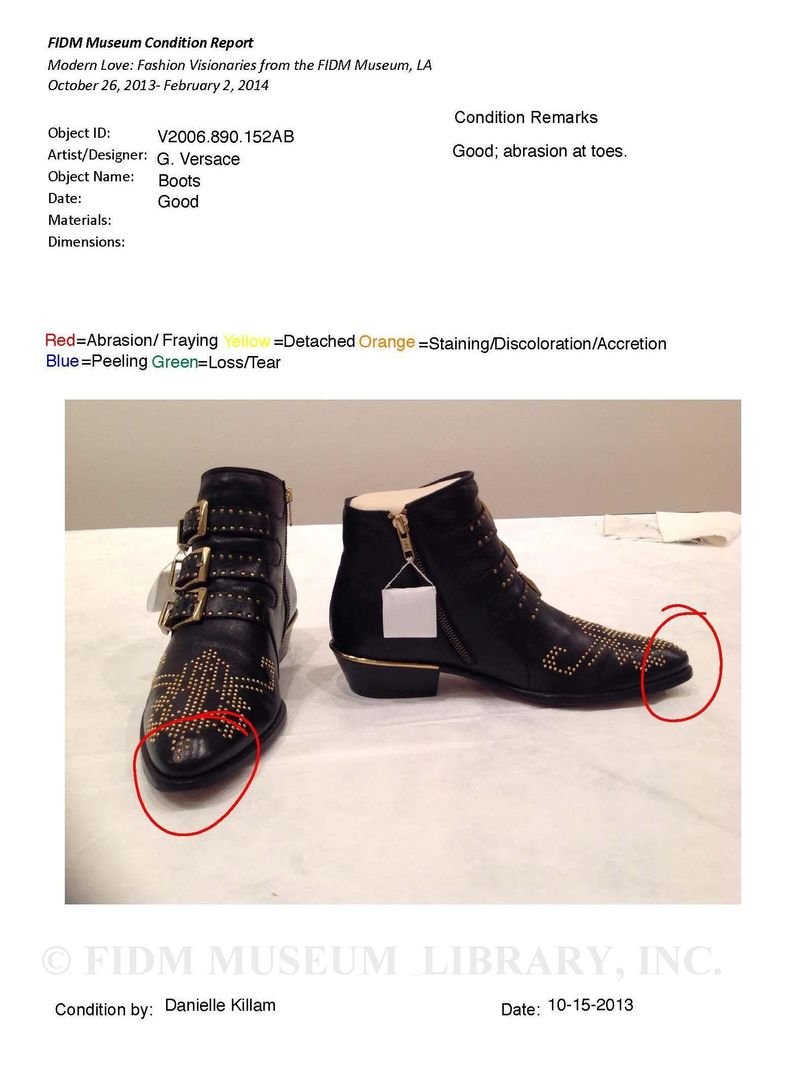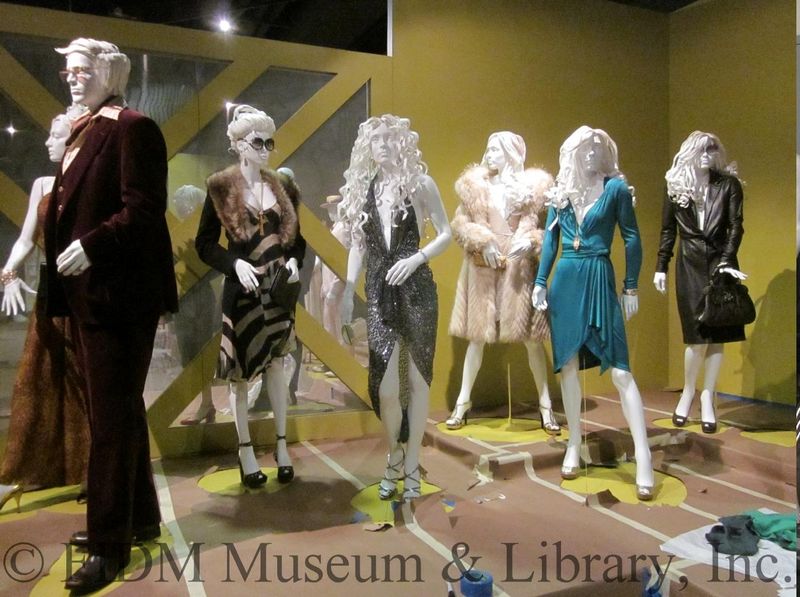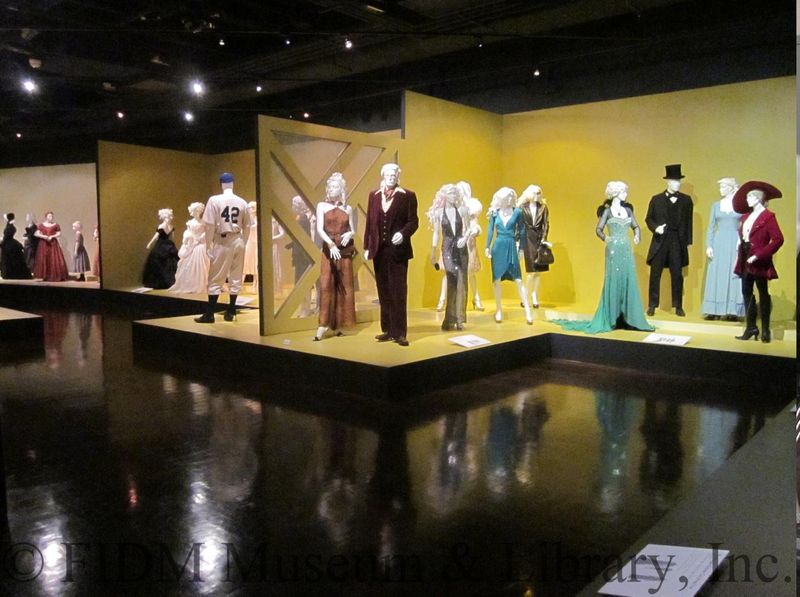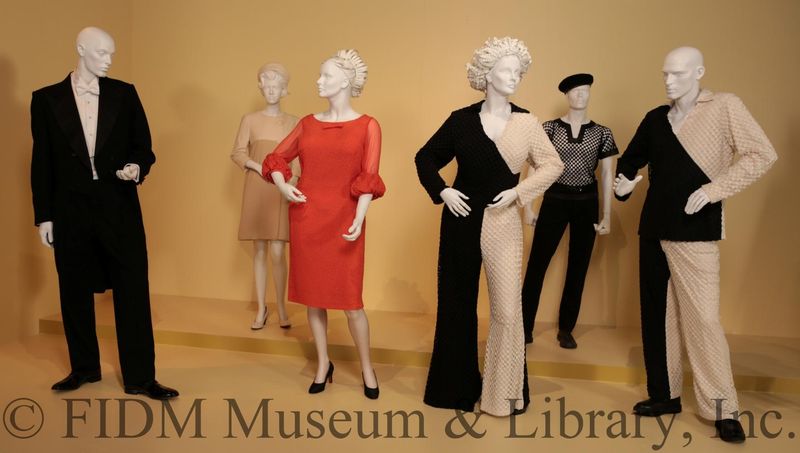Part two of Registrar Meghan Hansen's three-part post on producing the 22nd Annual Art of Motion Picture Costume Design Exhibition. Today's post focuses on a fascinating aspect of the process: matching costumes to mannequins.
**********
As I mentioned in my last post, the costumes loaned to FIDM Museum for this annual exhibition are received mere weeks before the exhibition opens. This presents a logistical challenge for everyone involved in the exhibition planning and execution. As a result, we have begun to use technology for condition reporting, in what used to be a pencil and paper game. The tablet allows the note-taker to quickly type inventory and condition information, as well as take photos within the same app. Photos can even be drawn on with a color-coded “marker” to indicate areas with condition issues.
 FIDM Museum digital condition report with inserted reference image and markings to indicate condition issues.
FIDM Museum digital condition report with inserted reference image and markings to indicate condition issues.
While it would be faster to skip the step of conditioning the objects, it is an essential part of our stewardship of the museum. These documents will be indispensible should there be a disagreement with a lender or an insurance claim. While we hope nothing of that sort happens, these are the things I must think about as the Museum Registrar. Be thankful you do not have to!
The next stage in receiving costumes is to measure them. This is done with mannequin-dressing in mind, which means that we don’t need every single measurement you might take, for example, to create a custom invisible mount (as seen here). But we need more than chest, waist, and hip. I find that the most important measurements for women include those three, but also the hem length (along with its intended position, such as knee-length or floor-length). For men, I require the distance between shoulder seams, inseam, and out-seam, in addition to a chest and waist measurement. I always measure the costume elements that are the most restrictive to the body: so for a man’s suit, I would base the shoulder measurement on the jacket instead of shirt, and the waist measurement on the pants instead of jacket.
 Suggested measurements for mannequin selection, as shown on the costume worn by Carey Mulligan as Daisy Buchanan in The Great Gatsby. Loan courtesy of Warner Bros. Pictures.
Suggested measurements for mannequin selection, as shown on the costume worn by Carey Mulligan as Daisy Buchanan in The Great Gatsby. Loan courtesy of Warner Bros. Pictures.
It’s a bit of a gamble to choose a mannequin for a costume worn by an actor.
 Initial mannequin selections for American Hustle; adjustments were made after the costumes were received, measured, and test-dressed.
Initial mannequin selections for American Hustle; adjustments were made after the costumes were received, measured, and test-dressed.
 American Hustle platform during installation. Loans courtesy of Sony Pictures, Michael Wilkinson, Gucci and Halston.
American Hustle platform during installation. Loans courtesy of Sony Pictures, Michael Wilkinson, Gucci and Halston.
 See the final American Hustle costumes in the center of this gallery view.
See the final American Hustle costumes in the center of this gallery view.
The FIDM Museum has a healthy supply of mannequins, but as you may have read on our previous blog posts (here and here), the process of dressing a garment on a mannequin for museum exhibition can be challenging, to say the least. I choose each mannequin for exhibition with a whole variety of factors in mind. First and foremost, the garment must fit the mannequin or be slightly larger than the mannequin. Museum practice dictates that museum objects must not be harmed or altered in mounting them for exhibition. As a result, the installer must alter the mannequin to fit the costume. This includes adding padding, prop petticoats or bustle pads, and even sometimes cutting off portions of the mannequin. We have been known to surgically remove feet, portions of the torso, or even heads!
For this year's exhibition, a number of mannequins were quickly altered to fit the clothes. In particular, Lee Daniels' The Butler required special accommodations. Can you guess what was done?
 The mannequin on the far left: feet were slimmed down to allow them to fit in narrow patent leather shoes. Mannequin third from right had a previous alteration—her feet were cut off at ankles—requiring further fixes to make her stand upright. Loan courtesy of The Weinstein Company
The mannequin on the far left: feet were slimmed down to allow them to fit in narrow patent leather shoes. Mannequin third from right had a previous alteration—her feet were cut off at ankles—requiring further fixes to make her stand upright. Loan courtesy of The Weinstein Company
While ‘surgical’ remedies are an option, they are not ideal, as they impact the future use-ability of the mannequin, sometimes ending the mannequin's life cycle with that final cut. So we try to preserve our mannequins intact as much as possible.

